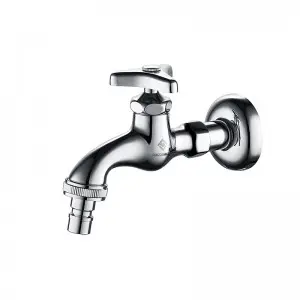Common materials for the faucet body include cast iron, plastic, alloy, stainless steel, copper, ceramic, etc.
cast iron faucet
Cast iron faucets are old-fashioned faucets. Because cast iron rusts easily, the exterior is usually painted with some paint to prevent rust. This type of faucet is relatively rough in manufacturing, easily pollutes water quality, and has a valve body that is prone to rust and leakage. Currently, it has basically been eliminated.
plastic faucet
Plastic faucets are generally made of PVC material with rich colors and can be mass-produced using molds. Plastic faucets have the characteristics of low price, corrosion resistance, light weight, high pressure resistance, rust-free and non-toxic. However, plastic faucets are not strong, have a short lifespan, and tend to make loud whistling sounds when water is discharged, which is very disturbing to residents.
Alloy faucet
Alloy faucets are similar to plastic faucets, are cheap and easy to mass produce. Most alloy faucets are made by sand casting process and machine die-casting. The biggest disadvantage is that blisters are prone to appear inside and the toughness is poor. Problems such as cracking often occur during use.
All copper faucet
Because copper has bactericidal and bacteriostatic effects, it is suitable as a faucet material. Moreover, all-copper faucets are excellent in corrosion resistance, acid and alkali resistance, and wear resistance, and can be said to be the best material for faucets. However, most of the faucets on the market are made of alloy copper, which is pure copper or 59 copper. Some products contain a small amount of lead, which is harmful to the human body.

stainless steel faucet
The biggest advantage of stainless steel faucets is that they do not contain lead, and like all copper materials, they are acid and alkali resistant, corrosion resistant, and have better hardness and toughness than pure copper. However, the processing of stainless steel products is relatively difficult, the technology is not yet mature, and the cost is relatively high.
ceramic faucet
Ceramic faucets have the advantages of good appearance, no rust, wear resistance, and no pollution of water sources. Ceramic faucets are very artistic and can be integrated into the design effect of the kitchen and bathroom. However, ceramic products are expensive and fragile, which are also the biggest disadvantages.
Household faucet material
Generally speaking, the best materials for household faucets are all copper, stainless steel and ceramics. Relatively speaking, the production process of copper faucets is the most mature, and it has good antibacterial and sterilizing effects. It is very suitable for use as a faucet. At present, pure copper faucets are in The market is also extremely popular.
Post time: Jan-11-2024













